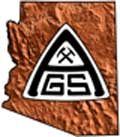

 Iron-sulfur
redox
and
its
effect on sulfur-isotope fractionation
in carbonate-hosted Cu-Au replacement ores, Superior, Arizona,
Iron-sulfur
redox
and
its
effect on sulfur-isotope fractionation
in carbonate-hosted Cu-Au replacement ores, Superior, Arizona, The porphyry-related carbonate-replacement
Cu-Au deposits at
Massive sulfide pods within broader hematite replacement bodies center on “feeder” veins and zone outward from central massive bornite-pyrite to chalcopyrite-pyrite ores before an abrupt, 10 cm wide transition to outer hematite-dominant ores. Field relationships and reaction path modeling indicate these zones formed contemporaneously as concentrically-nested, outwardly-encroaching ore zones.
HS- + 8Fe+3 + 4H2O = SO4-2 + 8Fe+2 + 9H+
Continued outward flow of the resulting SO4-rich fluid through the outer hematite body contained little reduced sulfur or ferrous iron, so deposited only minor disseminated pyrite there.
Sulfur isotopes of pyrite and chalcopyrite
in
sulfide-dominant ores near feeder veins range from δ34S =
-10.7 to
-4.1 per mil, whereas pyrite at the sharp hematite-sulfide contact has δ34S
=
0.0
per
mil,
and
disseminated
pyrites within the outer hematite zone
have δ34S
= +7.8 to +10.1 per mil. These sulfur
isotope compositions may reflect a
Near feeder veins where pyrite replaced hematite, redox formation of SO4-2 may have concentrated 34S in sulfate (i.e., a form inaccessible to pyrite formation).
H34S- + 32SO4-2 → H32S- + 34SO4-2
The remaining isotopically lighter HS- would have reacted with iron to deposit 32S-rich pyrite and stripped the fluid of some 32S. Outward flow of the fluid carried isotopically heavier sulfur into the peripheral hematite zone. Such hydrothermal fluids were greatly depleted of reduced sulfur species, and thus deposited only disseminated pyrite using the remaining, “distilled” heavy fraction of sulfur. Isotope exchange with sulfate released by dissolution of earlier-formed anhydrite that originally deposited near the carbonate-hematite reaction front may also have contributed to heavier sulfur in the peripheral sulfides. The bimodal distribution of sulfide- and hematite-dominant ores suggests ore fluids transported more iron than could be deposited by accompanying HS- and the sharp contact between these zones formed at the reaction front where HS- was exhausted.
